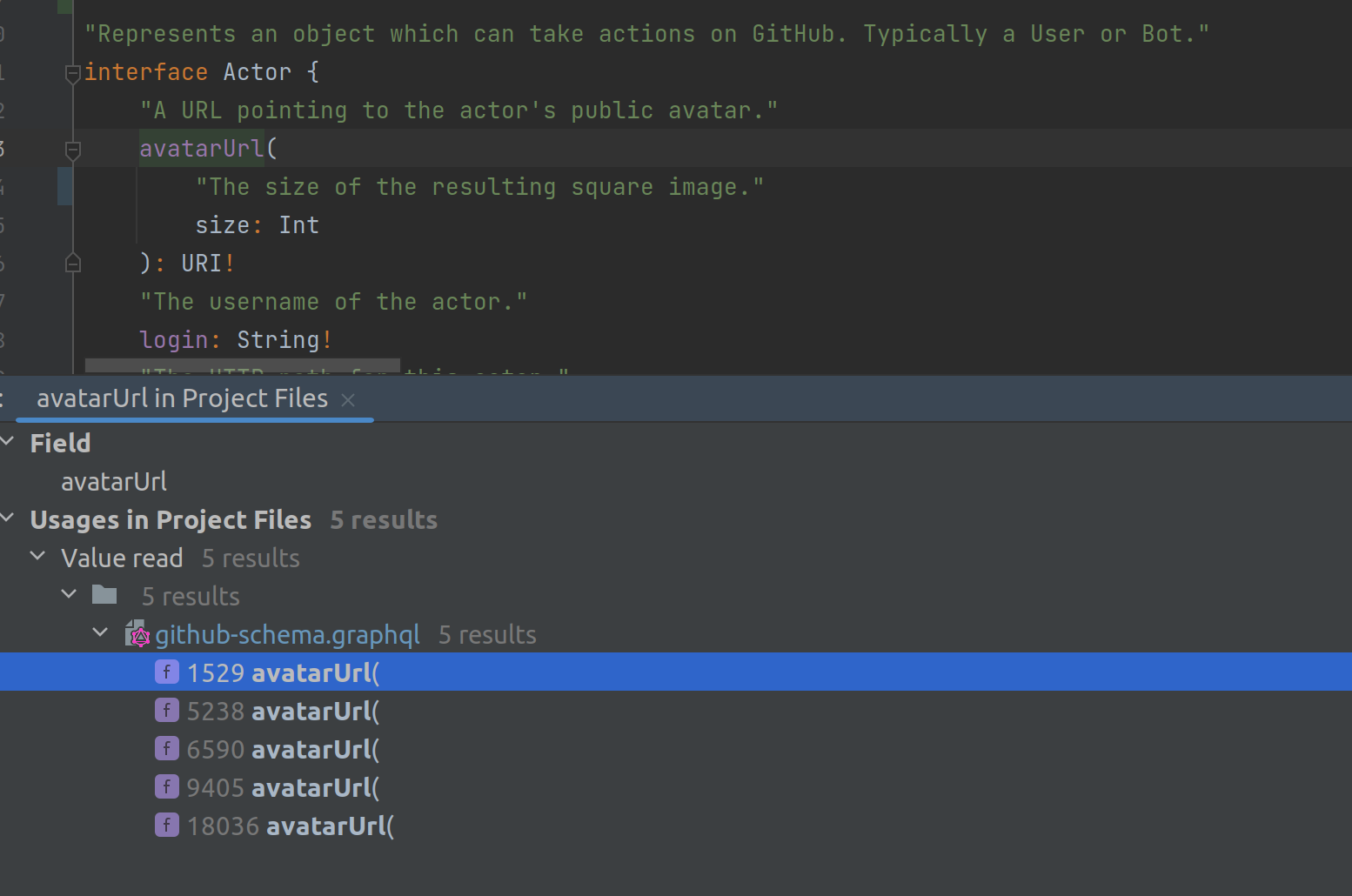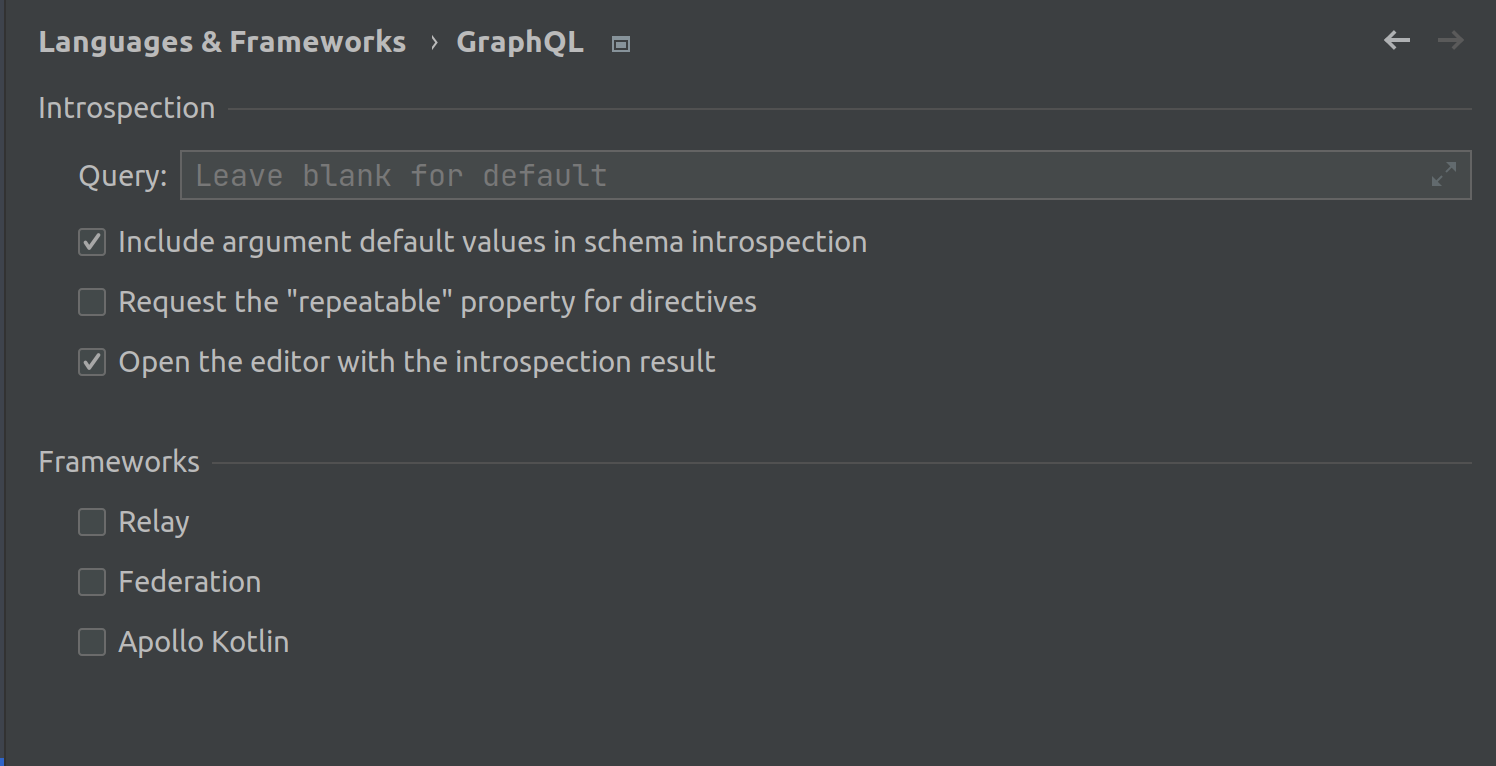GraphQL language support for WebStorm, IntelliJ IDEA and all other IDEs. The plugin works with all IDEs in the IntelliJ Platform.
The plugin and this documentation assume you are already familiar with the GraphQL language. If you're not, please visit the official graphql.org website first. The plugin works out of the box with popular GraphQL clients such as Apollo GraphQL and Relay, but you're free to choose your client and server framework.
The plugin is available from JetBrains Marketplace.
You can install it directly from your IDE via the File | Settings/Preferences | Plugins screen.
On the Marketplace tab simply search for graphql and select the GraphQL suggestion:
This developer guide covers how to set up your project to get the most out of the GraphQL language tooling in this plugin.
The main features of this plugin include:
-
Full language support for GraphQL Specification including the Schema Definition Language (SDL).
-
Schema-aware completion, error highlighting, and documentation.
-
Syntax highlighting, code-formatting, folding, commenter, and brace-matching.
-
The plugin discovers your local schema on the fly. Remote schemas are easily fetched using introspection. You can introspect GraphQL endpoints to generate schema declaration files using the GraphQL Type System Definition Language.
-
Support for multi-schema projects using configurable project scopes or
graphql-configfiles. Schema discovery is configured using graphql-config v2 files, which includes support for multi-schema projects. -
Built-in support for Relay and Apollo projects:
graphqlandgqltagged template literals in JavaScript and TypeScript are automatically recognized as GraphQL. -
Execute queries using variables against configurable endpoints, including support for custom headers and environment variables.
-
Find UsagesandGo to Declarationfor schema types, fields, and fragments. -
Structure viewto navigate GraphQL files -
Load variables from shell or
.envfiles. Supported file names:.env.local,.env.development.local,.env.development,.env.dev.local,.env.dev,.env -
Built-in
Relay,Federation, andApollo Kotlintype definitions (You need to enable it inPreferences / Settings | Languages & Frameworks | GraphQL).
It is important to configure how the schema types are discovered. If the schema types are not discovered correctly, language features such as completion and error highlighting will be based on the wrong type information.
Schemas and their types are declared using GraphQL Type System Definition Language, which is also widely known as GraphQL Schema Definition Language (often abbreviated as SDL). If you're authoring your schemas in SDL, the plugin provides the following features:
- Completion for types when defining fields, arguments, implemented interfaces, and so on.
- Error highlighting of schema errors such as unknown types, wrong use of types, and missing fields when implementing interfaces.
- Find usages in SDL and refactoring such as rename, which will update the relevant queries, mutations, and so on.
For use cases where you don't declare the schema in the project, an introspection query can be executed against a GraphQL endpoint URL to write the schema to a .graphql file as SDL. See Working with GraphQL Endpoints.
By default, the plugin assumes that your project contains a single schema. If this is the case, you don't need to perform any actions in
terms of schema discovery. For a single-schema project, schema types are discovered as follows: All .graphql files in the "Project files"
scope are processed for type definitions, which are added to a singleton type registry. If the IDE has JavaScript language support, injected
GraphQL strings in the Project files scope are processed for all JavaScript file types. File extensions include .js, .jsx, .ts,
and .tsx.
Injected GraphQL is found based on Tagged Template Literals with one of the following tags: graphql, .gql, or Relay.QL.
For projects with multiple schemas, developers have to configure a scope for each schema. The purpose of a schema-specific scope is to
prevent types from being picked up in more than one GraphQL type registry, which would likely result in validation errors. This is because
these types will appear to have been declared more than once. In addition, the scopes prevent non-conflicting types from showing up in
completions and ensure that validation only recognizes the types that belong to the current schema. The plugin allows you to configure your
schema scopes using graphql-config v2 configuration files with includes and excludes glob patterns.
Please familiarize yourself with the graphql-config v2 format
before proceeding.
The next step is to decide where to place the .graphqlconfig file. The config file controls schema discovery from the directory it's placed
in, as well as any subfolders that don't have their own .graphqlconfig. To create a .graphqlconfig file, right-click a folder and select
New GraphQL Configuration File or use the "+" button in the GraphQL Tool window tab named Schemas and Project Structure. Depending on your
preference, you can use a single .graphqlconfig file in a folder that is a parent to each schema folder, or you can place .graphqlconfig
files in each schema folder.
Option A: Multiple config files (recommended):
- project root/
- product a (schema one)/
- .graphqlconfig <-----
- schema files and graphql aware components
- product b (schema two)/
- .graphqlconfig <-----
- schema files and graphql aware components
With this approach the location of the config files creates separate scopes for the two schemas.
Option B: Single config file:
- project root/
- .graphqlconfig <-----
- product a (schema one)/
- schema files and graphql aware components
- product b (schema two)/
- schema files and graphql aware components
With a single config file you need to separate the schemas using the includes globs of the projects field:
{
"projects": {
"product a": {
"includes": ["product a (schema one)/**"]
},
"product b": {
"includes": ["product b (schema two)/**"]
}
}
}See https://github.com/jimkyndemeyer/graphql-config-examples for example of uses of .graphqlconfig to control schema discovery.
You can use GraphQL scratch files to work with your schema outside product code, for example, for writing temporary queries to test
resolvers. To run queries or mutations against your GraphQL endpoint, add your endpoint details to a .graphqlconfig file. If you don't
already have a config file, you can create one by right-clicking on your project base dir and choosing New | GraphQL Configuration File.
If you already have a config file, you can jump to it using the Edit .graphqlconfig toolbar button in the top left of the scratch file
editor. See https://github.com/kamilkisiela/graphql-config/tree/legacy#specifying-endpoint-info for the expected format of the endpoint
details such as the URL, headers, and so on.
The following example is from graphql-config-examples/remote-schema-introspection.
It demonstrates how to use the endpoints configured in .graphqlconfig to fetch an existing remote schema.
With introspect: true the plugin asks at project startup whether to update the local schema using the configured endpoint.
The update works by sending an introspection query to the endpoint, and then writing the result to the configured schemaPath.
Introspection queries can also be executed by double-clicking Endpoints in the schemas tree view:
 Notes and comments:
If you're both developing the server schema and consuming it in a client, e.g. via component queries, you'll get the best tooling by having
your schema expressed using GraphQL Schema Definition Language directly in your project. With this setup, the plugin immediately discovers
your schema and you don't have to perform an introspection after the server schema changes.
Notes and comments:
If you're both developing the server schema and consuming it in a client, e.g. via component queries, you'll get the best tooling by having
your schema expressed using GraphQL Schema Definition Language directly in your project. With this setup, the plugin immediately discovers
your schema and you don't have to perform an introspection after the server schema changes.
Tip: The re-run introspection action can be bound to a keyboard shortcut for convenience.
Supported tags are: graphql, gql, Relay.QL, Apollo.gql.
const QUERY = gql``;
// language=GraphQL
const QUERY = `query { field }`;
const QUERY = /* GraphQL */ `query { field }`;
const QUERY = `
#graphql
query { field }
`;This plugin was heavily inspired by GraphiQL from Facebook.
A number of language features such as query and schema validation are powered by graphql-java.
A thanks also goes out to the Apollo and Prisma teams for their continued efforts to improve the GraphQL developer experience.
And finally, a thank you to the JetBrains WebStorm team and the Alpha/Beta testers for all their help.
MIT







